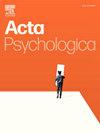你的谎言不会让我心寒评估测谎的直接、间接和生理指标。
IF 2.7
4区 心理学
Q2 PSYCHOLOGY, EXPERIMENTAL
引用次数: 0
摘要
人们往往不善于识破谎言:当被明确要求推断他人说的是假话还是真话时,人们的表现往往不会好于偶然。然而,越来越多的证据表明,内隐测谎方法和潜在的生理测谎方法可能会反映观察者分辨谎言和真相的能力。内隐反应和生理反应被认为是对谎言的反应,是一种与威胁反应相关的威胁性刺激。因此,说假话的人应该比说真话的人更不被人喜欢和信任(间接测谎法)。从生理学角度来看,威胁反应应该与血管变窄(血管收缩)有关,这会减少外周皮肤的血流量。因此,我们预计当面对谎言时,手指温度会比面对真相时低。我们使用显性和间接测量方法测试测谎,并使用红外热成像作为测谎的生理测量方法。参与者(95 人)观看了人们就其社会关系说假话或真话的视频,期间参与者的指尖温度被记录下来。结果表明,显性分类的准确性仍处于偶然水平。对讲故事者的好感度和可信度(测谎的间接指标)的判断显示,没有证据表明观察者可以区分说谎者和讲真话者:那些被认为是说真话的人比那些被认为是说谎者的人更受喜欢和信任,即使这种想法是错误的。利用热成像技术进行的生理测谎也失败了:观察者的指尖温度在谎言和真实故事之间并无明显差异。如果有的话,温度效应的方向与谎言即威胁的预期相反:与真实故事相比,面对谎言时指尖温度会有所上升。研究结果支持了人们不善于识别谎言的印象,并对指尖温度反应是否可用作谎言识别机制表示怀疑。本文章由计算机程序翻译,如有差异,请以英文原文为准。
Your lies don't leave me cold: Assessing direct, indirect and physiological measures of lie detection
People tend to be bad at detecting lies: When explicitly asked to infer whether others tell a lie or the truth, people often do not perform better than chance. However, increasing evidence suggests that implicit lie detection measures and potentially physiological measures may mirror observers' telling apart lies from truths after all. Implicit and physiological responses are argued to respond to lies as a threatening stimulus associated with a threat response. Subsequently, people who tell a lie should thus be liked and trusted less than those who tell the truth (indirect lie detection measures). In terms of physiology, a threat response should be associated with narrowing blood vessels (vasoconstriction), which should reduce peripheral skin blood flow. Consequently, we expected lower finger temperatures when confronted with a lie compared to the truth. We test lie detection using explicit and indirect measures, as well as using infrared thermal imaging as a physiological measure of lie detection. Participants (N = 95) observed videos of people telling lies or the truth about their social relationships, during which participants' fingertip temperature was recorded. Results suggested that the accuracy of explicit categorizations remained at chance level. Judgments of story-tellers' likability and trustworthiness (indirect measures of lie detection) showed no evidence that observers could tell apart liars and truthtellers: Those believed to be truthtellers were liked and trusted significantly more than those believed to be liars, even when this belief was mistaken. Physiological lie detection measured using thermal imaging also failed: Observers' fingertip temperatures did not significantly differ between lies and true stories. If at all, the temperature effects pointed in the opposite direction of the lies-as-threat expectations: Fingertip temperatures increased somewhat while confronted with lies compared to true stories. Results support the impression that people are bad at detecting lies, and cast doubt on whether fingertip temperature responses could be used as lie detection mechanisms.
求助全文
通过发布文献求助,成功后即可免费获取论文全文。
去求助
来源期刊

Acta Psychologica
PSYCHOLOGY, EXPERIMENTAL-
CiteScore
3.00
自引率
5.60%
发文量
274
审稿时长
36 weeks
期刊介绍:
Acta Psychologica publishes original articles and extended reviews on selected books in any area of experimental psychology. The focus of the Journal is on empirical studies and evaluative review articles that increase the theoretical understanding of human capabilities.
 求助内容:
求助内容: 应助结果提醒方式:
应助结果提醒方式:


